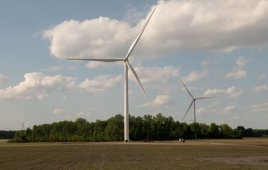Wind measurement systems: Measuring wind speed and direction is now done at least three ways: mechanically (cup anemometer with a vane), with ultrasonics, or with laser-based devices. There are variations to each. Mechanical sensors, for instance, use moving parts and still connect to data recording devices. The anemometer uses spinning cups for wind speed and a vane for vector changes. These physically move with changes in the wind and give accurate readings of speed and direction.
Ultrasonic sensors function without moving parts. On a typical sonic anemometer, a transducer sends a pulse of ultrasonic sound from a ‘north’ facing side of the sensor. A microprocessor measures the time it takes to travel to a ‘South’ transducer. The wind speed is calculated from the time it takes the ultrasound to travel to the opposite transducer. Measurement times are affected by the wind speed and direction blowing along the line between the transducers. Without moving parts, measurement is said to be immediate and precise.
In the cases above, the instruments are small enough to mount on a nacelle. Larger, ground-mounted sonic instruments, however, can take the place of a met tower and measure wind speed and direction at several elevations.
This latter device, also called a sonic wind profiler or a sodar (sound detection and ranging) unit, detects wind speeds and directions at several levels up to about 300 m. The unit is said to work unattended to capture accurate wind data at turbine heights in any weather and location. one model runs on as little as 7 W from a battery recharged by a solar panel, and it can be relocated by one man with a truck. Readings from these devices look like anemometry results and so need no expert analysis. Users can often access data in real time from a computer over a satellite wind data service.
Sodar uses short-wavelength sound waves to measure the Doppler shift of emitted sound and calculate wind speeds. Sodar units are reported have performed well in tests.
Laser-based wind sensors use laser Doppler velocimetry – an optical remote-sensing technique similar to Doppler radar – to measure minute frequency changes of light reflected by microscopic air particles moving with the wind which precisely determines wind speed and direction. One laser wind sensor mounts atop the turbine nacelle (pointing through the rotor) to measure real-time horizontal and vertical wind speed and directions in front of the turbine. This sensor looks out to 300 m ahead of the turbine to measure wind speed and direction as it approaches the turbine blades. It transmits that data to the controls in time (20 sec of lead time for a 35-mph wind) to reorient the turbine. The system is comprised of a base laser and a remote lens. The base unit, housed in a separate assembly, can be mounted inside the turbine’s nacelle. The remote lens mounts atop the nacelle. According to one report, reacting to oncoming wind before it reaches a turbine improves power production by about 10%.
Filed Under: Uncategorized




